Prediction Method of Aeroengine Rotor Assembly Errors Based on a Novel Multi-Axis Measuring and Connecting Mechanism
Abstract
1. Introduction
2. Classification and Propagation of the Error Sources in Rotor Connecting Processes
3. Modeling of the Error Sources in Rotor Connecting Processes
3.1. Modeling of the Shape and Position Errors of Rotors
3.2. Modeling of the Measurement Errors of Rotors
3.2.1. Measurement Errors on the Flange End Faces
3.2.2. Measurement Errors on the Rabbet Joint Structures
3.3. Modeling of the Six-Axis Mechanism Errors and Mounting Errors
3.4. Modeling of the Rotor Final Assembly Errors
4. Construction and Application of the Rotor Assembly Error Prediction Algorithm
4.1. Procedure of the Prediction Algorithm
4.2. Inputs of the Prediction Algorithm
4.3. Results of the Prediction Algorithm
5. Verification Experiment
6. Conclusions
- (1)
- The kurtosis and skewness of the distributions of all predicted assembly errors are positive. When the rotor process capability index CP is set to 1.00, 1.33, and 1.67, respectively, the average values of the assembly position errors are = 0.149, 0.118, and 0.099 mm; = 0.051, 0.050, and 0.049 mm; and = 0.064, 0.063, and 0.062 mm, respectively; the average values of assembly pose errors are = 0.294′, 0.227′, and 0.184′; = 0.203′, 0.166′, and 0.145′; and = 0.236′, 0.194′, and 0.169′, respectively. Detailed statistical results are obtained using the proposed prediction method;
- (2)
- If CP improves from 1.00 to 1.33, and then to 1.67, the decline rates of , ,, and range from 12.0% to 23.0%, while the decline rates of and are small. The last two assembly position errors are insensitive to changes in rotor shape and position errors, because they take a long-distance common line as reference. In general, the improvement in the rotor shape and position accuracy reduces most assembly errors to varying degrees;
- (3)
- The connection qualification rate is higher than 97% when the rotors have general or high shape and position accuracy (i.e., CP ≥ 1.33). Even if the rotors have relatively low accuracy (i.e., CP = 1.00), the connection qualification rate achieves 88.9%. It is significantly higher than the qualification rate of less than 50% when using the traditional manual connection processes. According to the predictions, the new mechanical system (three-axis CMM, the six-axis rotor connecting mechanism, and clamping fixture) has high applicability for rotors with different accuracy levels;
- (4)
- Predictions and experiments based on three aeroengine rotor assemblies show that: The min-max ranges of the six assembly errors obtained from 30 experiments for each assembly are within those of the corresponding 100,000 predicted results. The deviation rates of the corresponding experimental average values of the six assembly errors relative to those of the predictions are all lower than 14%. The proposed prediction method has acceptable accuracy and practical significance.
Author Contributions
Funding
Institutional Review Board Statement
Informed Consent Statement
Data Availability Statement
Conflicts of Interest
Nomenclature
| AFi/FFi | Aft/fore flange end face on the i-th rotor |
| AFNi/FFNi | Nominal aft/fore flange end face without any shape or position errors on the i-th rotor |
| AJi/FJi | Aft/fore rabbet joint structure on the i-th rotor |
| AN1 | Aft nominal end face on the 1st rotor |
| a1/2/3 | Fitting parameter of annular end face |
| B | Basic coordinate system |
| b1/2/3/4 | Fitting parameter of the cylindrical face |
| Process capability index | |
| Error transformation matrix from A to B | |
| Nominal diameter of aft/fore flange end face on the i-th rotor (mm) | |
| Differential matrix of | |
| Eij | The j-th positioning structure on the i-th rotor |
| Distance between the j-th positioning structure and nominal aft flange end face on the i-th rotor (mm) | |
| Actual/nominal distance between fore and aft flange end faces on the i-th rotor (mm) | |
| M | Measuring coordinate system |
| N | Total number of virtual assemblies under the same connecting condition |
| Position column matrix in | |
| Element in position column matrix | |
| NMF/MJ | Number of points for measuring annular end face/cylindrical face |
| First/second/third pose column matrix in excluding last element 0 | |
| The k-th nominal point on the j-th circular path for measuring annular end face of the i-th rotor | |
| The j-th nominal point for measuring cylindrical face of the i-th rotor | |
| / | Measured point/Projection of measured point |
| Radius of the j-th circular path for measuring annular end face (mm) | |
| Radius of the cylindrical face (mm) | |
| Rotation transformation matrix | |
| Matrix of rolling, pitching, and yawing | |
| Transformation matrix from A to B (A/B is the reference/current coordinate system) | |
| Obtained transformation matrix after measurement and fitting | |
| Target matrix for generating NC instructions | |
| Transformation matrix when six axes are at their calibrated zero points | |
| Translation transformation matrix | |
| Rotor shape and position tolerance | |
| Anti-collision clearance (mm) | |
| Concentricity of aft/fore rabbet joint structure of the i-th rotor (mm) | |
| Concentricity of the j-th positioning structure on the i-th rotor (mm) | |
| Comprehensive measuring accuracy of CMM system (mm) | |
| Aft/fore flange end face run-out of the i-th rotor (mm) | |
| / | Assembly position/pose error of iF-th positioning structure on fore iF-th rotor relative to iA-th positioning structure on aft iA-th rotor |
| / | Assembly position/pose error of iM-th positioning structure on middle iM-th rotor relative to common reference line OEiFiF-OEiAiA |
| / | Linear/rotational motion error in six-axis mechanism |
| Transformed angle value representing parallel error of axis of j-th positioning structure on i-th rotor (′) | |
| D-H parameters of six-axis mechanism | |
| Circumferential angle of / (rad) | |
| Standard deviation of rotor shape and position error | |
| Standard deviation of motion error of six-axis mechanism | |
| Deflection angle of rolling/pitching/yawing of the 1st rotor (rad) | |
| Deflection direction of axis of the j-th positioning structure on the i-th rotor caused by parallel error (rad) | |
| Circumferential angle between high points of fore and aft flange end faces on i-th rotor (rad) | |
| Connecting circumferential angle between the i-th and (i+1)-th rotors (rad) | |
| Direction of aft/fore rabbet center deviation of the i-th rotor (rad) | |
| Direction of center deviation of the j-th positioning structure on the i-th rotor (rad) |
References
- Sun, C.; Hu, M.; Liu, Y.; Zhang, M.; Liu, Z.; Chen, D.; Tan, J. A method to control the amount of unbalance propagation in precise cylindrical components assembly. Proc. Inst. Mech. Eng. B J. Eng. Manuf. 2019, 233, 2458–2468. [Google Scholar] [CrossRef]
- Liu, A.; Ju, Y.; Zhang, C. Parallel rotor/stator interaction methods and steady/unsteady flow simulations of multi-row axial compressors. Aerosp. Sci. Technol. 2021, 116, 106859. [Google Scholar] [CrossRef]
- Jin, S.; Ding, S.; Li, Z.; Yang, F.; Ma, X. Point-based solution using Jacobian-Torsor theory into partial parallel chains for revolving components assembly. J. Manuf. Syst. 2018, 46, 46–58. [Google Scholar] [CrossRef]
- Zhu, Y.; Huang, X.; Fang, W.; Li, S. Trajectory Planning Algorithm Based on Quaternion for 6-DOF Aircraft Wing Automatic Position and Pose Adjustment Method. Chin. J. Aeronaut. 2010, 23, 707–714. [Google Scholar]
- Lee, N.K.S.; Yu, G.; Joneja, A.; Ceglarek, D. The modeling and analysis of a butting assembly in the presence of workpiece surface roughness and part dimensional error. Int. J. Adv. Manuf. Technol. 2006, 31, 528–538. [Google Scholar] [CrossRef]
- Sun, H.; Wang, J.; Chen, K.; Xia, H.; Feng, X.; Chang, Z. A tip clearance prediction model for multistage rotors and stators in aero-engines. Chin. J. Aeronaut. 2021, 34, 343–357. [Google Scholar] [CrossRef]
- Liu, J.; Jin, J.; Shi, J. State Space Modeling for 3-D Variation Propagation in Rigid-Body Multistage Assembly Processes. IEEE Trans. Autom. Sci. Eng. 2010, 7, 274–290. [Google Scholar]
- Zhang, Z.; Zhang, Z.; Jin, X.; Zhang, Q. A novel modelling method of geometric errors for precision assembly. Int. J. Adv. Manuf. Technol. 2017, 94, 1139–1160. [Google Scholar] [CrossRef]
- Bakker, O.J.; Popov, A.A.; Ratchev, S.M. Variation analysis of automated wing box assembly. Procedia CIRP 2017, 63, 406–411. [Google Scholar] [CrossRef]
- Peng, Y.; Hao, L.; Huang, X.; Li, S. A pre-assembly analysis technology of aircraft components based on measured data. Meas. Sci. Technol. 2022, 33, 075005. [Google Scholar] [CrossRef]
- Sun, C.; Li, C.; Liu, Y.; Liu, Z.; Wang, X.; Tan, J. Prediction Method of Concentricity and Perpendicularity of Aero Engine Mul-tistage Rotors Based on PSO-BP Neural Network. IEEE Access 2019, 7, 132271–132278. [Google Scholar] [CrossRef]
- Ding, S.; Jin, S.; Li, Z.; Chen, H. Multistage rotational optimization using unified Jacobian-Torsor model in aero-engine assembly. Proc. Inst. Mech. Eng. B J. Eng. Manuf. 2019, 233, 251–266. [Google Scholar] [CrossRef]
- Zhang, T.; Zhang, Z.; Jin, X.; Ye, X.; Zhang, Z. An innovative method of modeling plane geometric form errors for precision assembly. Proc. Inst. Mech. Eng. B J. Eng. Manuf. 2016, 230, 1087–1096. [Google Scholar] [CrossRef]
- Sun, Q.; Zhao, B.; Liu, X.; Mu, X.; Zhang, Y. Assembling deviation estimation based on the real mating status of assembly. Comput. Aided Des. 2019, 115, 244–255. [Google Scholar] [CrossRef]
- Sun, C.; Liu, Z.; Liu, Y.; Wang, X.; Tan, J. An Adjustment Method of Geometry and Mass Centers for Precision Rotors Assembly. IEEE Access 2019, 7, 169992–170002. [Google Scholar] [CrossRef]
- Mu, X.; Wang, Y.; Yuan, B.; Sun, W.; Liu, C.; Sun, Q. A New assembly precision prediction method of aeroengine high-pressure rotor system considering manufacturing error and deformation of parts. J. Manuf. Syst. 2021, 61, 112–124. [Google Scholar] [CrossRef]
- Lowth, S.; Axinte, D.A. An assessment of “variation conscious” precision fixturing methodologies for the control of circularity within large multi-segment annular assemblies. Precis. Eng. 2014, 38, 379–390. [Google Scholar] [CrossRef][Green Version]
- Sun, C.; Wang, B.; Liu, Y.; Wang, X.; Li, C.; Wang, H.; Tan, J. Design of high accuracy cylindrical profile measurement model for low-pressure turbine shaft of aero engine. Aerosp. Sci. Technol. 2019, 95, 105442. [Google Scholar] [CrossRef]
- Wang, J.; Sun, Q.; Yuan, B. Novel on-machine measurement system and method for flatness of large annular plane. Meas. Sci. Technol. 2020, 31, 015004. [Google Scholar] [CrossRef]
- Yu, L.; Zhang, Y.; Bi, Q.; Wang, Y. Research on surface normal measurement and adjustment in aircraft assembly. Precis. Eng. 2017, 50, 482–493. [Google Scholar] [CrossRef]
- Jamshidi, J.; Kayani, A.; Iravani, P.; Maropoulos, P.G.; Summers, M.D. Manufacturing and assembly automation by integrated metrology systems for aircraft wing fabrication. Proc. Inst. Mech. Eng. B J. Eng. Manuf. 2010, 224, 25–36. [Google Scholar] [CrossRef]
- Díaz-Tena, E.; Ugalde, U.; de Lacalle, L.N.L.; de la Iglesia, A.; Calleja, A.; Campa, F.J. Propagation of assembly errors in multitasking machines by the homogenous matrix method. Int. J. Adv. Manuf. Technol. 2013, 68, 149–164. [Google Scholar] [CrossRef]
- Lin, P.D.; Tzeng, C.S. Modeling and measurement of active parameters and workpiece home position of a multi-axis machine tool. Int. J. Mach. Tools Manuf. 2008, 48, 338–349. [Google Scholar] [CrossRef]
- Lei, P.; Zheng, L. An automated in-situ alignment approach for finish machining assembly interfaces of large-scale com-ponents. Robot. Comput. Int. Manuf. 2017, 46, 130–143. [Google Scholar] [CrossRef]
- Papastathis, T.; Ryll, M.; Bone, S.; Ratchev, S. Development of a Reconfigurable Fixture for the Automated Assembly and Disassembly of High Pressure Rotors for Rolls-Royce Aero Engines. In Precision Assembly Technologies and Systems. IPAS 2010; Ratchev, S., Ed.; IFIP Advances in Information and Communication Technology; Springer: Berlin/Heidelberg, Germany, 2010; Volume 315, pp. 283–289. [Google Scholar] [CrossRef]
- Ramesh, R.; Mannan, M.A.; Poo, A.N. Error compensation in machine tools—A review Part I: Geometric, cutting-force induced and fixture-dependent errors. Int. J. Mach. Tools Manuf. 2000, 40, 1235–1256. [Google Scholar] [CrossRef]
- Chen, Z.; Du, F.; Tang, X. Position and orientation best-fitting based on deterministic theory during large scale assembly. J. Intell. Manuf. 2018, 29, 827–837. [Google Scholar] [CrossRef]
- Yang, Z.; Hussain, T.; Popov, A.A.; McWilliam, S. Novel Optimization Technique for Variation Propagation Control in An Aero-Engine Assembly. Proc. Inst. Mech. Eng. B J. Eng. Manuf. 2011, 225, 100–111. [Google Scholar] [CrossRef]
- Yang, H.; Tsai, P. Mathematical model of S-shaped gear surface. J. Mech. Sci. Technol. 2021, 35, 2841–2850. [Google Scholar] [CrossRef]
- Li, Y.; Zhang, L.; Wang, Y. An optimal method of posture adjustment in aircraft fuselage joining assembly with engineering constraints. Chin. J. Aeronaut. 2017, 30, 2016–2023. [Google Scholar] [CrossRef]
- Whitney, D.E.; Gilbert, O.L.; Jastrzebski, M. Representation of geometric variations using matrix transforms for statistical tolerance analysis in assemblies. Res. Eng. Des. 1994, 6, 191–210. [Google Scholar] [CrossRef]
- Wu, Y.; Chen, C. An automatic generation method of the coordinate system for automatic assembly tolerance analysis. Int. J. Adv. Manuf. Technol. 2018, 95, 889–903. [Google Scholar] [CrossRef]
- Zhang, M.; Liu, Y.; Sun, C.; Wang, X.; Tan, J. Measurements error propagation and its sensitivity analysis in the aero-engine multistage rotor assembling process. Rev. Sci. Instrum. 2019, 90, 115003. [Google Scholar] [CrossRef] [PubMed]
- Zhou, Z.; Liu, W.; Wu, Q.; Wang, Y.; Yu, B.; Yue, Y.; Zhang, J. A Combined Measurement Method for Large-Size Aerospace Components. Sensors 2020, 20, 4843. [Google Scholar] [CrossRef] [PubMed]
- Iwasa, T.; Harada, T. A Precise Connection Method for Surface Shape Data Measured by the Grating Projection Method. Trans. Jpn. Soc. Aeronaut. Space Sci. 2016, 59, 251–257. [Google Scholar] [CrossRef][Green Version]
- Ahn, H.K.; Kang, H.; Ghim, Y.; Yang, H. Touch Probe Tip Compensation Using a Novel Transformation Algorithm for Co-ordinate Measurements of Curved Surfaces. Int. J. Precis. Eng. Man. 2019, 20, 193–199. [Google Scholar] [CrossRef]
- Deng, Z.; Li, S.; Huang, X. A flexible and cost-effective compensation method for leveling using large-scale coordinate measuring machines and its application in aircraft digital assembly. Meas. Sci. Technol. 2018, 29, 065904. [Google Scholar] [CrossRef]
- Calvo, R. Sphericity measurement through a new minimum zone algorithm with error compensation of point coordinates. Measurement 2019, 138, 291–304. [Google Scholar] [CrossRef]
- Hu, Q.; Zhang, D.; Wu, Z. Trajectory planning and tracking control for 6-DOF Stanford manipulator based on adaptive sliding mode multi-stage switching control. Int. J. Robust Nonlinear Control 2021, 31, 6602–6625. [Google Scholar] [CrossRef]
- Cai, L.; Zhang, Z.; Cheng, Q.; Liu, Z.; Gu, P.; Qi, Y. An approach to optimize the machining accuracy retainability of multi-axis NC machine tool based on robust design. Precis. Eng. 2016, 43, 370–386. [Google Scholar] [CrossRef]
- Zhou, W.; Chen, W.; Liu, H.; Li, X. A new forward kinematic algorithm for a general Stewart platform. Mech. Mach. Theory 2015, 87, 177–190. [Google Scholar] [CrossRef]
- Yang, J.; Ding, H. A new position independent geometric errors identification model of five-axis serial machine tools based on differential motion matrices. Int. J. Mach. Tools Manuf. 2016, 104, 68–77. [Google Scholar] [CrossRef]
- Guo, J.; Li, B.; Liu, Z.; Hong, J.; Zhou, Q. A new solution to the measurement process planning for machine tool assembly based on Kalman filter. Precis. Eng. 2016, 43, 356–369. [Google Scholar] [CrossRef]
- Chen, J.-X.; Lin, S.-W.; Zhou, X.-L. A comprehensive error analysis method for the geometric error of multi-axis machine tool. Int. J. Mach. Tools Manuf. 2016, 106, 56–66. [Google Scholar] [CrossRef]
- Tang, W.; Li, Y.; Yu, J.; Zhang, J.; Yu, L. Locating error analysis for workpieces with general fixture layouts and parameterized tolerances. Proc. Inst. Mech. Eng. B J. Eng. Manuf. 2016, 230, 416–427. [Google Scholar] [CrossRef]
- Fallah, M.; Arezoo, B. Modelling and compensation of fixture locators’ error in CNC milling. Int. J. Prod. Res. 2013, 51, 4539–4555. [Google Scholar] [CrossRef]
- Vallance, R.R.; Morgan, C.; Slocum, A.H. Precisely positioning pallets in multi-station assembly systems. Precis. Eng. 2004, 28, 218–231. [Google Scholar] [CrossRef]
- Wei, P.; Lu, Z.; Song, J. Extended Monte Carlo Simulation for Parametric Global Sensitivity Analysis and Optimization. AIAA J. 2014, 52, 867–878. [Google Scholar] [CrossRef]
- Wu, F.; Cao, X.; Butcher, E.A.; Wang, F. Dynamics and control of spacecraft with a large misaligned rotational component. Aerosp. Sci. Technol. 2019, 87, 207–217. [Google Scholar] [CrossRef]
- Wen, X.; Zhao, Y.; Wang, D.; Pan, J. Adaptive Monte Carlo and GUM methods for the evaluation of measurement uncertainty of cylindricity error. Precis. Eng. 2013, 37, 856–864. [Google Scholar] [CrossRef]
- Schwenke, H.; Knapp, W.; Haitjema, H.; Weckenmann, A.; Schmitt, R.; Delbressine, F. Geometric error measurement and compensation of machines—An update. CIRP Ann. 2008, 57, 660–675. [Google Scholar] [CrossRef]
- Cui, G.; Lu, Y.; Li, J.; Gao, D.; Yao, Y. Geometric error compensation software system for CNC machine tools based on NC program reconstructing. Int. J. Adv. Manuf. Technol. 2012, 63, 169–180. [Google Scholar] [CrossRef]
- Guo, C.; Liu, J.; Jiang, K. Efficient statistical analysis of geometric tolerances using unified error distribution and an analytical variation model. Int. J. Adv. Manuf. Technol. 2016, 84, 347–360. [Google Scholar]
- Yang, Z.; McWilliam, S.; Popov, A.A.; Hussain, T. A probabilistic approach to variation propagation control for straight build in mechanical assembly. Int. J. Adv. Manuf. Technol. 2013, 64, 1029–1047. [Google Scholar] [CrossRef]
- Wang, Q.; Huang, P.; Li, J.; Ke, Y. Uncertainty evaluation and optimization of INS installation measurement using Monte Carlo Method. Assem. Autom. 2015, 35, 221–233. [Google Scholar] [CrossRef]
- Cui, Z.; Du, F. Assessment of large-scale assembly coordination based on pose feasible space. Int. J. Adv. Manuf. Technol. 2019, 104, 4465–4474. [Google Scholar] [CrossRef]
- Tang, H.; Li, C.; Zhang, Z.; Ko, T.J. A novel geometric error modeling optimization approach based on error sensitivity analysis for multi-axis precise motion system. J. Mech. Sci. Technol. 2019, 33, 3435–3444. [Google Scholar] [CrossRef]
- Liu, Y.; Yuan, M.; Cao, J.; Cui, J.; Tan, J. Evaluation of measurement uncertainty in H-drive stage during high acceleration based on Monte Carlo method. Int. J. Mach. Tools Manuf. 2015, 93, 1–9. [Google Scholar] [CrossRef]
- Liu, Y.; Zhang, M.; Sun, C.; Hu, M.; Chen, D.; Liu, Z.; Tan, J. A method to minimize stage-by-stage initial unbalance in the aero engine assembly of multistage rotors. Aerosp. Sci. Technol. 2019, 85, 270–276. [Google Scholar] [CrossRef]
- Fruciano, C. Measurement error in geometric morphometrics. Dev. Genes Evol. 2016, 226, 139–158. [Google Scholar] [CrossRef]
- Chao, M.T.; Lin, D. Another look at the process capability index. Qual. Reliab. Eng. Int. 2006, 22, 153–163. [Google Scholar] [CrossRef]
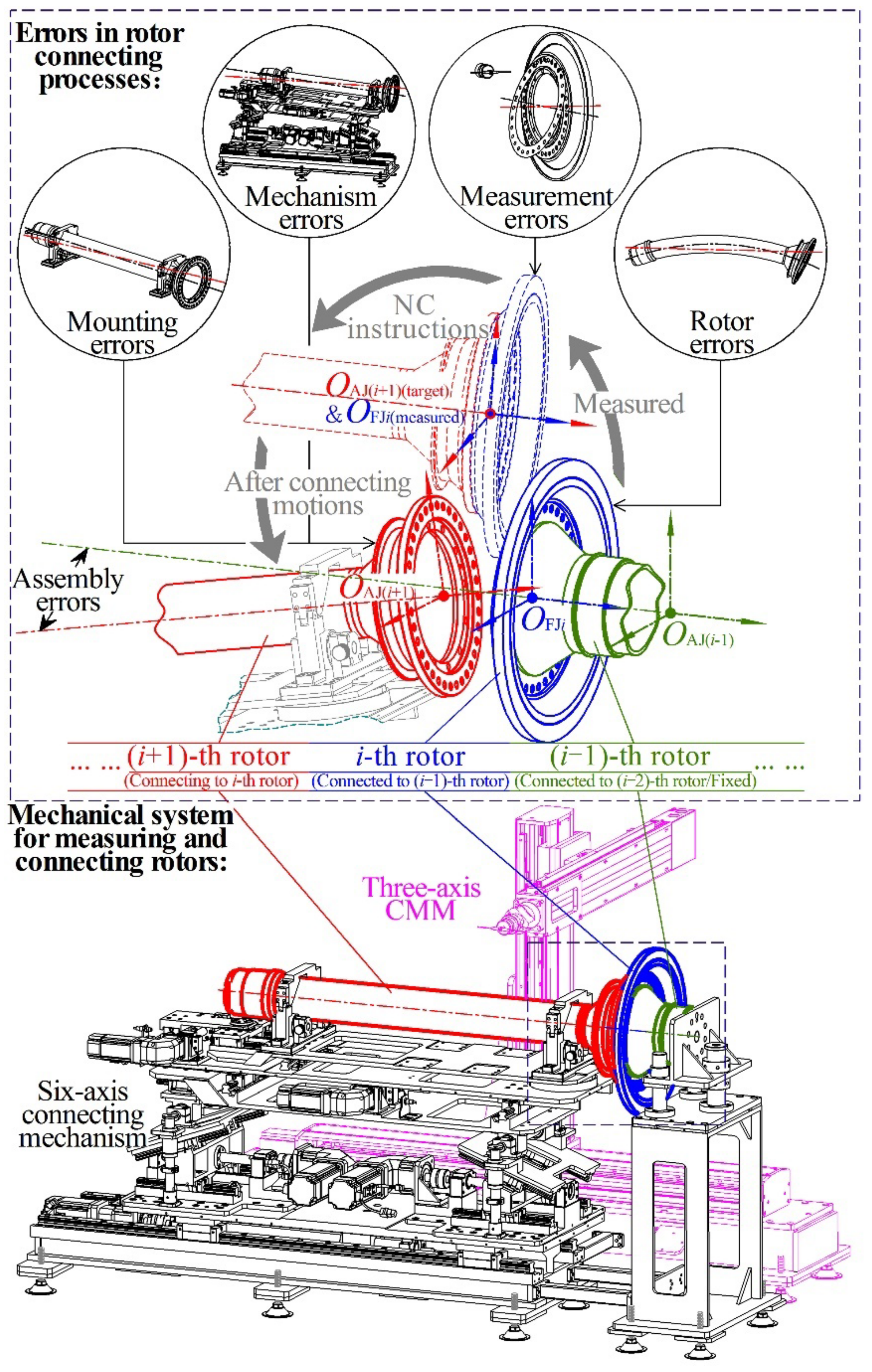
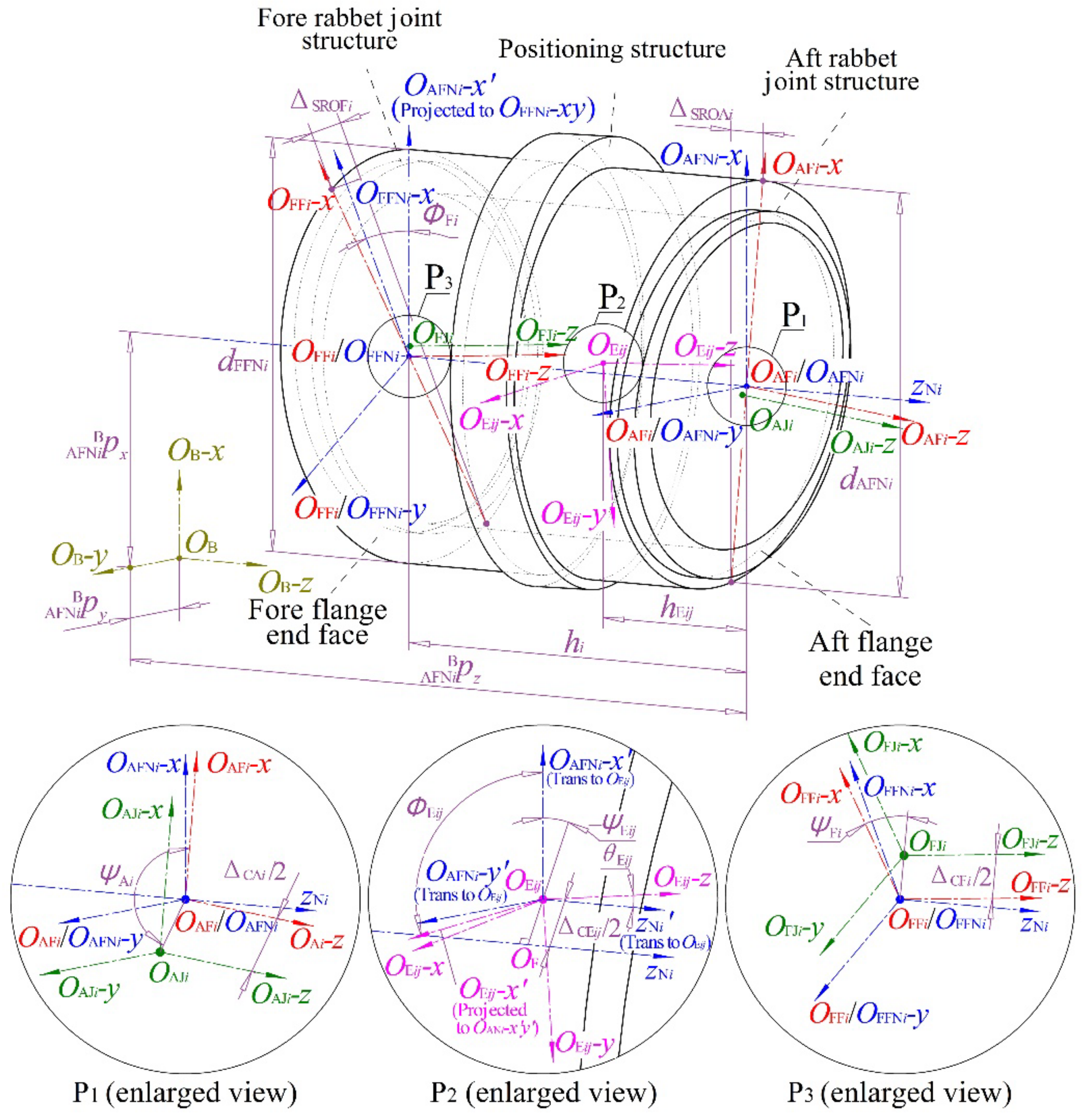
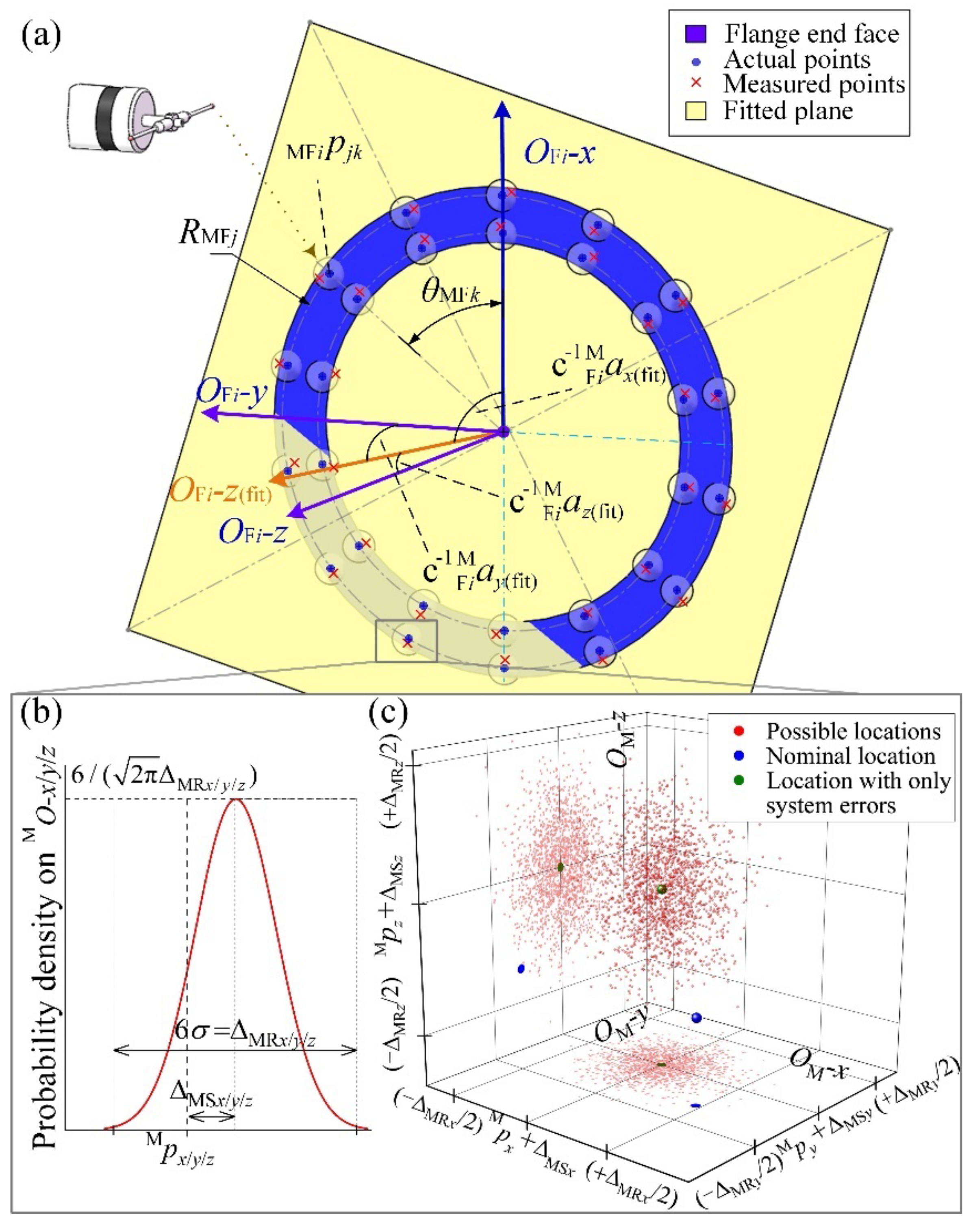
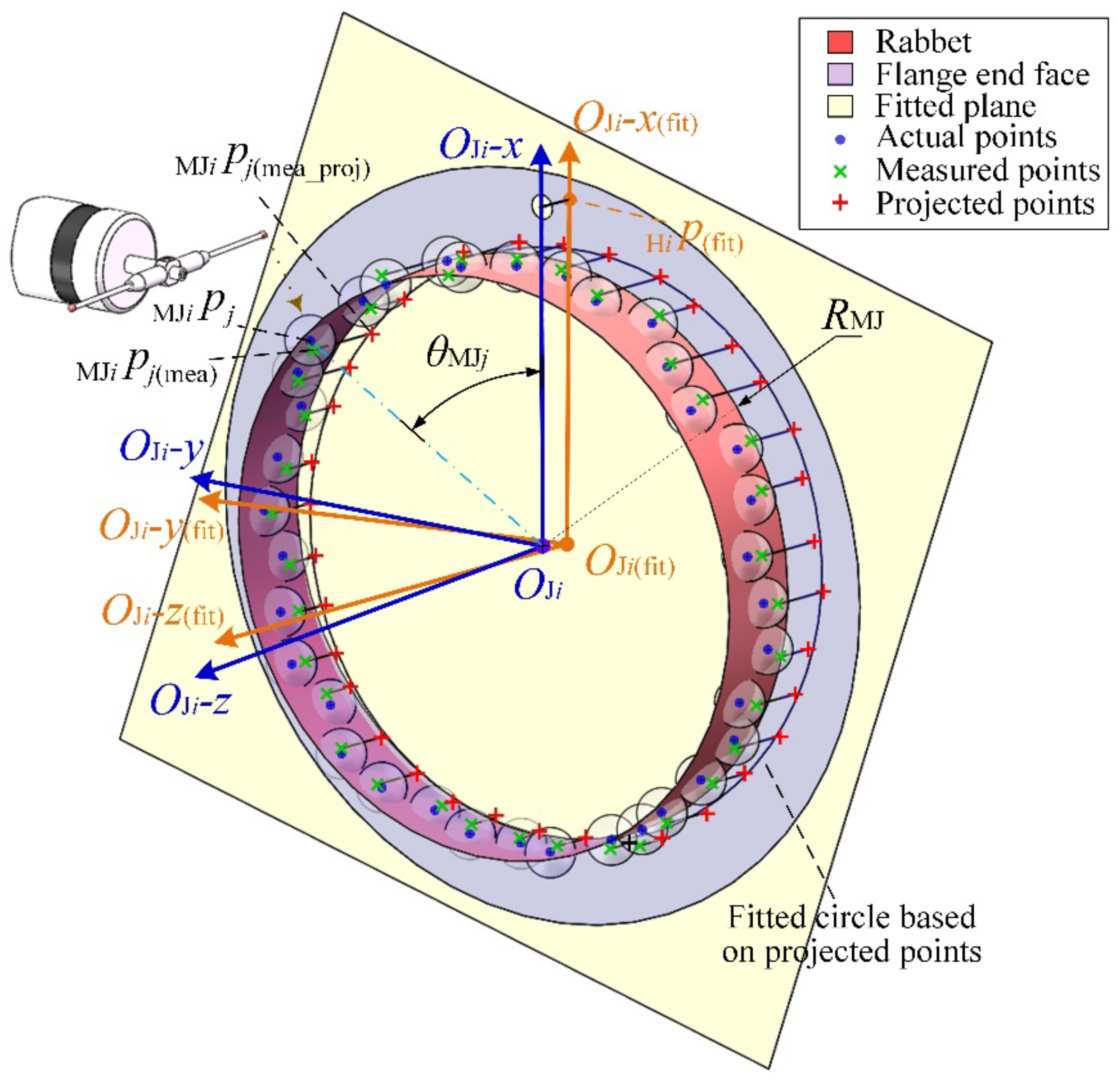
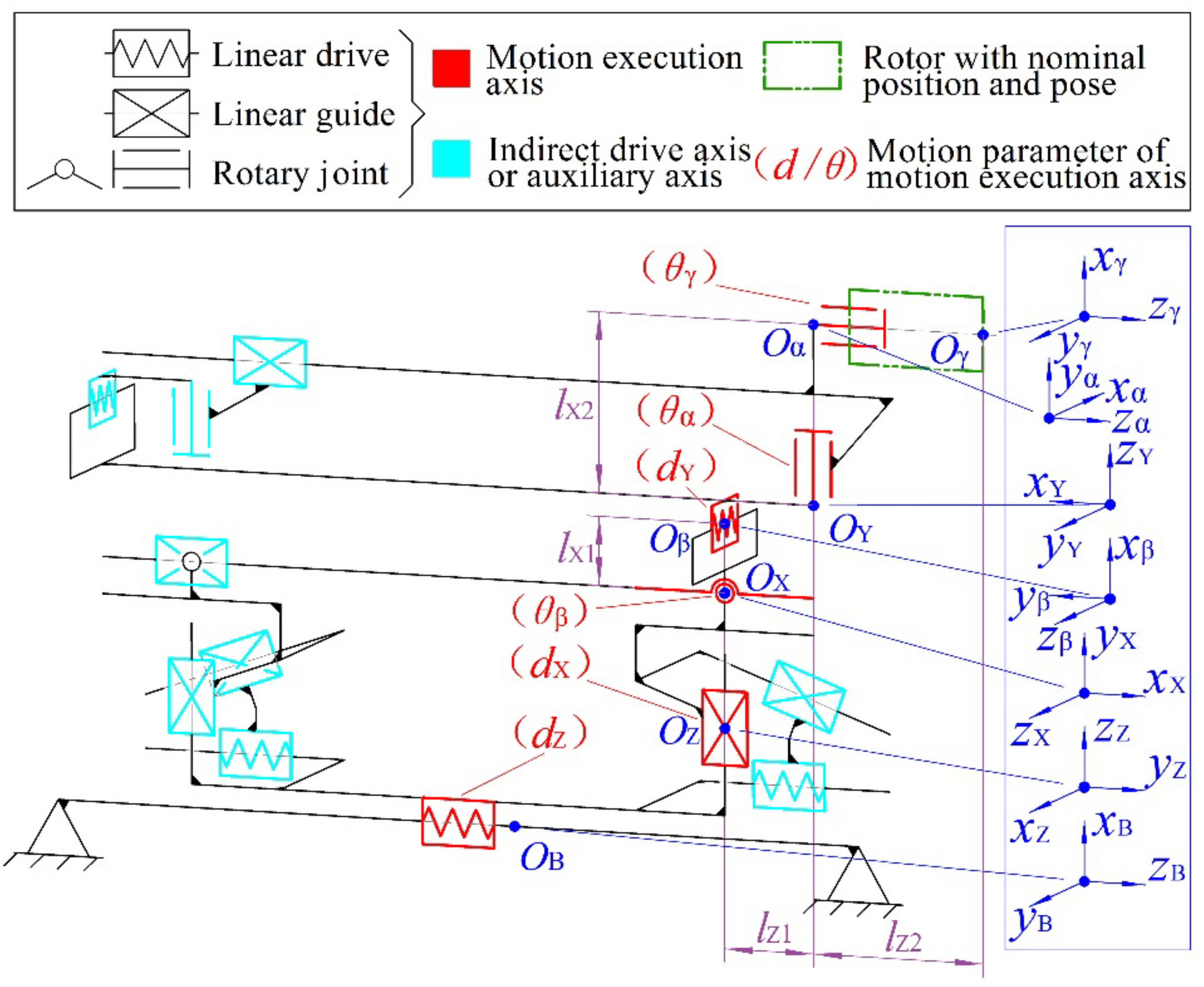
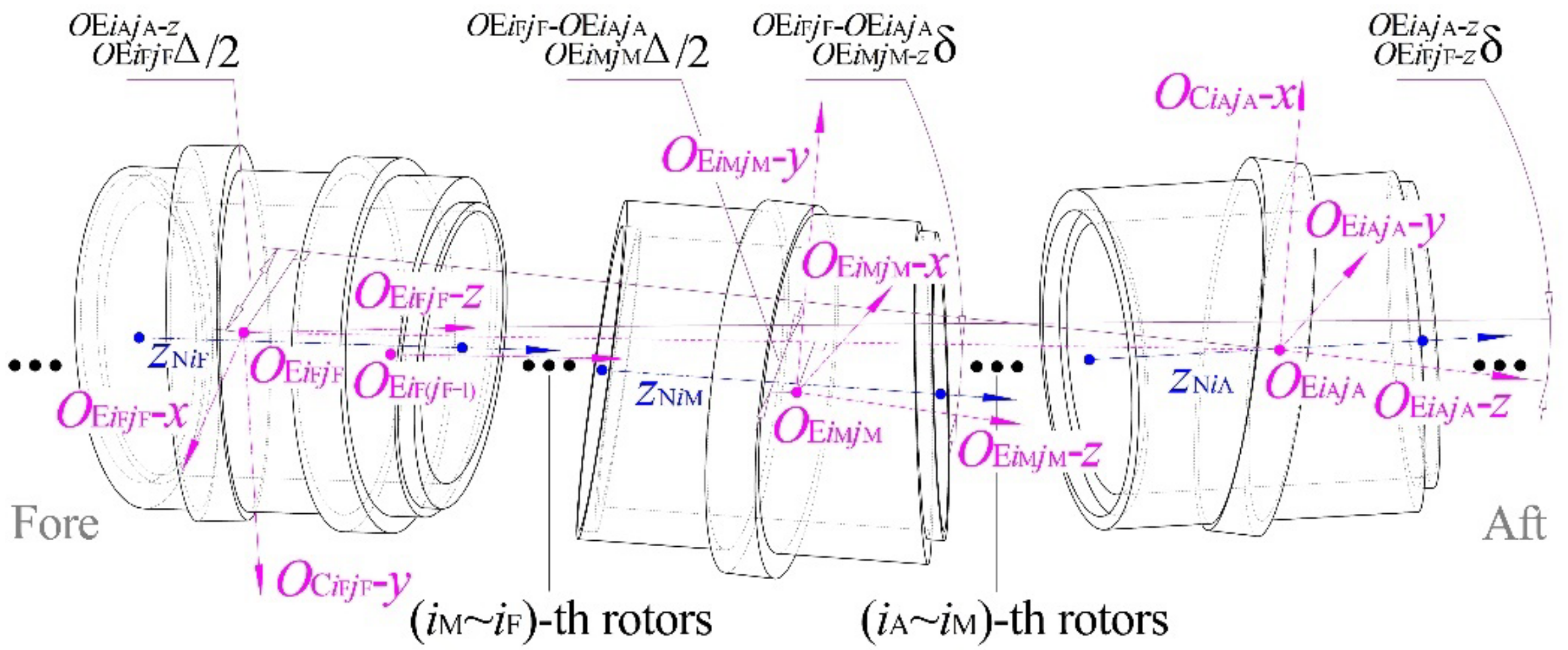
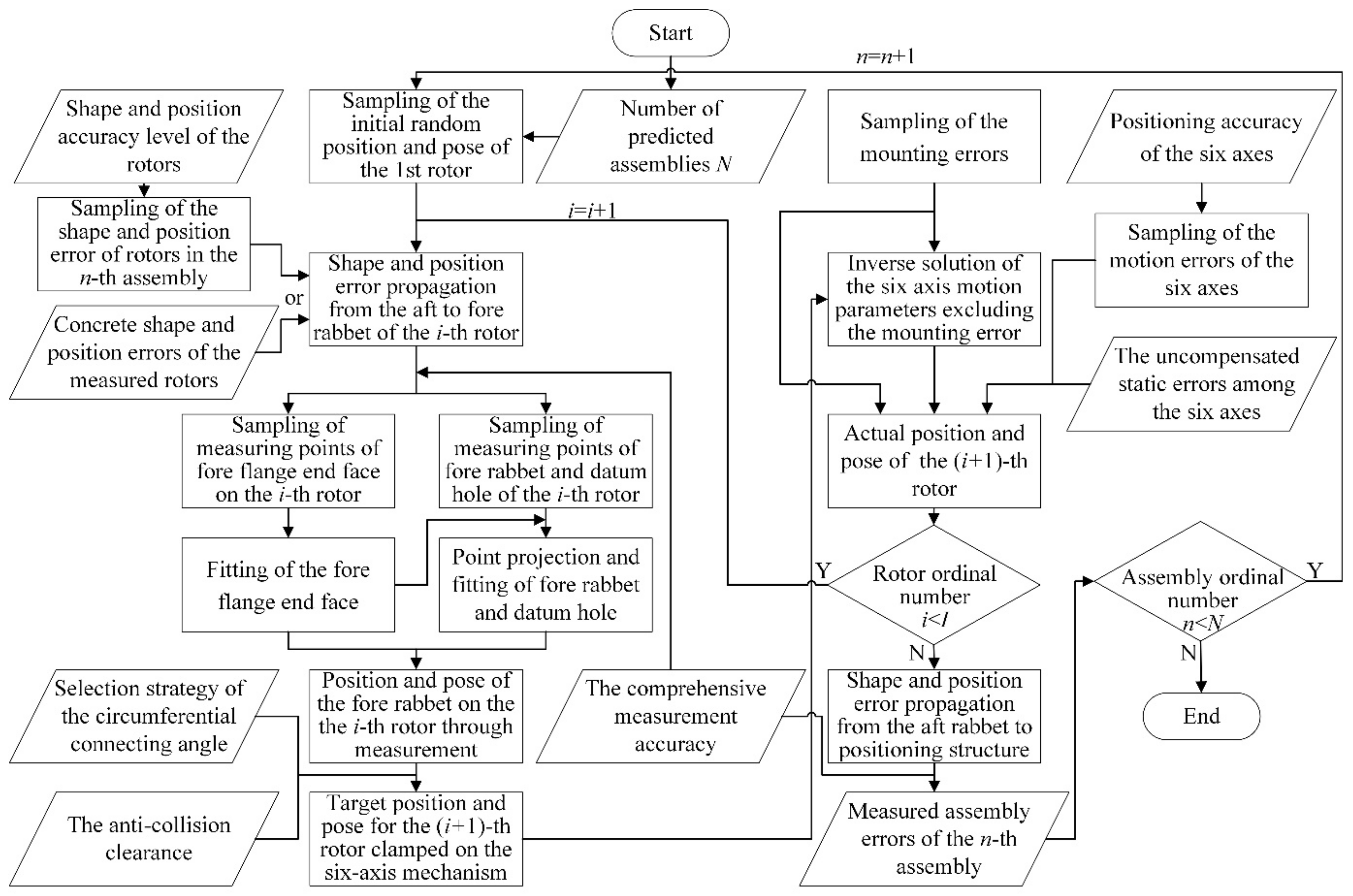
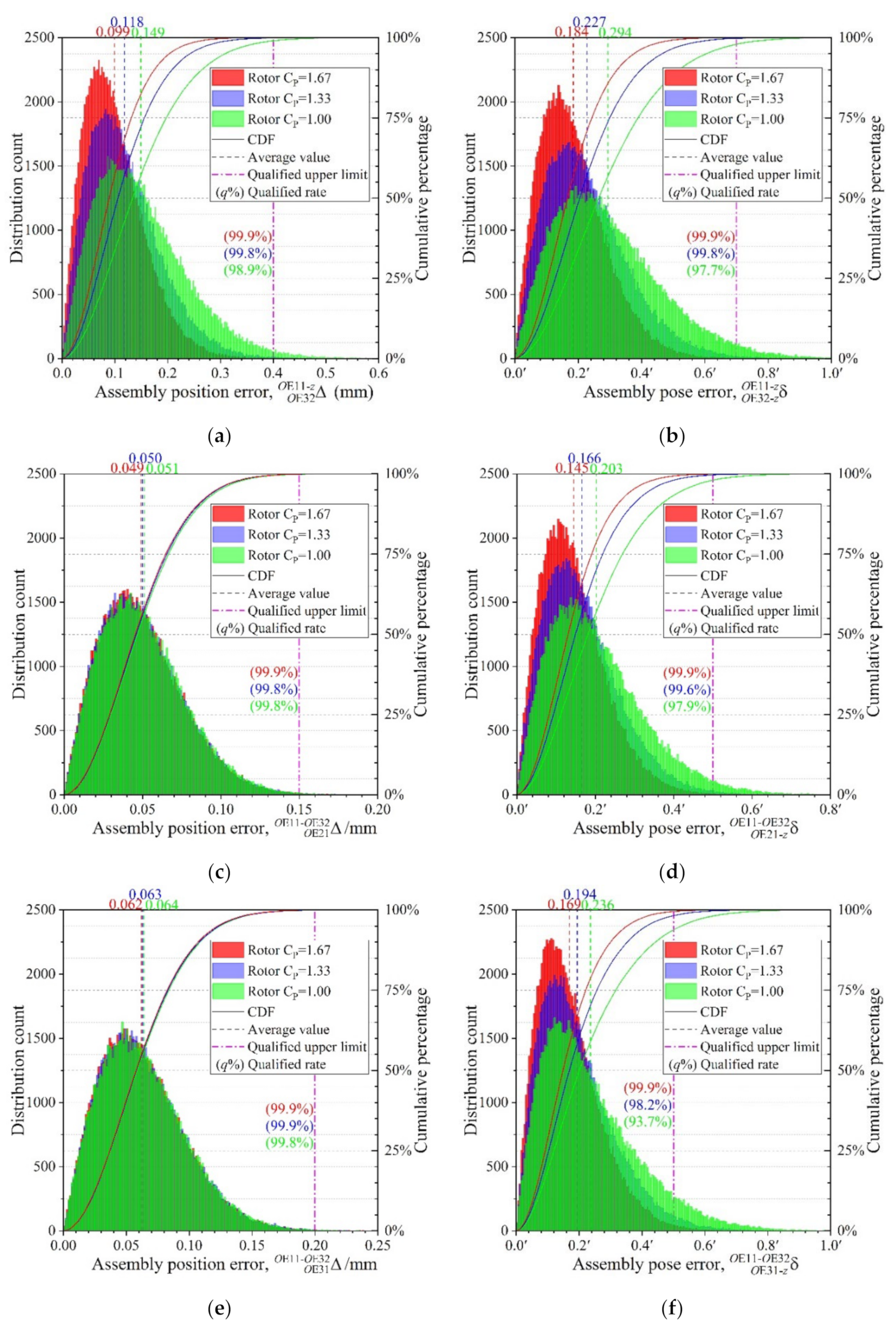
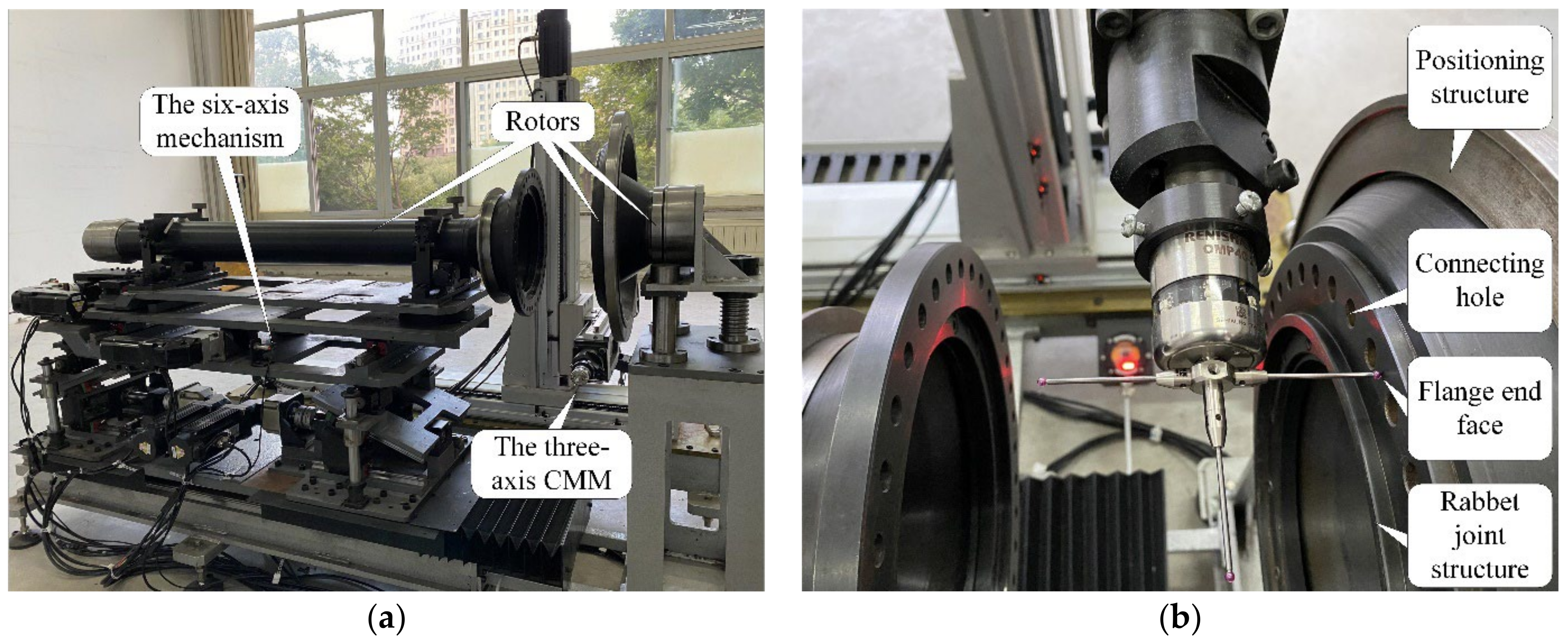
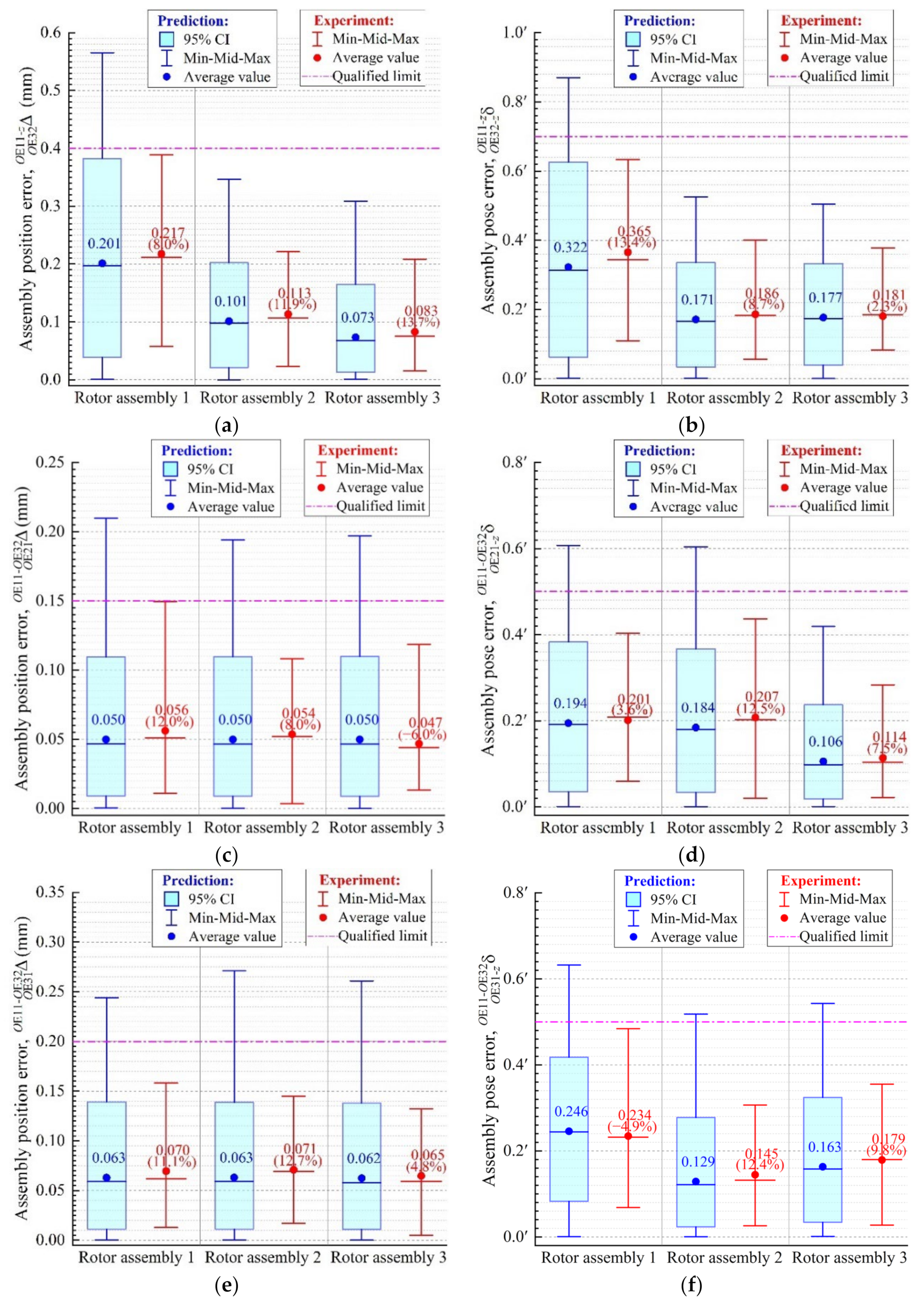
| Item | |||||
|---|---|---|---|---|---|
| σR | 0.010/CP | 0.010/CP | 0.005/CP | 0.003/CP | 0.143′/CP |
| Assembly 1 | 0.012 | 0.001 | 0.001 | 0.001 | 0.216′ |
| Assembly 2 | 0.016 | 0.004 | 0.012 | 0.003 | 0.012′ |
| Assembly 3 | 0.002 | 0.006 | 0.005 | 0.001 | 0.065′ |
| Item | ||||||
|---|---|---|---|---|---|---|
| σR | 0.005/CP | 0.013/CP | 0.013/CP | 0.005/CP | 0.010/CP | 0.160′/CP |
| Assembly 1 | 0.001 | 0.020 | 0.016 | 0.004 | 0.004 | 0.131′ |
| Assembly 2 | 0.001 | 0.011 | 0.019 | 0.003 | 0.001 | 0.122′ |
| Assembly 3 | 0.006 | 0.011 | 0.011 | 0.003 | 0.015 | 0.036′ |
| Item | ||||||
|---|---|---|---|---|---|---|
| σR | 0.005/CP | 0.013/CP | 0.008/CP | 0.230′/CP | 0.003/CP | 0.176′/CP |
| Assembly 1 | 0.003 | 0.003 | 0.011 | 0.227 | 0.003 | 0.080′ |
| Assembly 2 | 0.002 | 0.007 | 0.005 | 0.069 | 0.003 | 0.075′ |
| Assembly 3 | 0.001 | 0.014 | 0.009 | 0.128 | 0.004 | 0.152′ |
| Item | Aft Flange of the 1st Rotor | Aft Flange of the 2nd Rotor | Positioning Structure of the 1st Rotor | Positioning Structure of the 2nd Rotor | The 1st Positioning Structure of the 3rd Rotor | The 2nd Positioning Structure of the 3rd Rotor |
|---|---|---|---|---|---|---|
| 22 | 28 | 14 | 38 | 22 | 12 | |
| (mm) | 104 | 125 | 79 | 191 | 107 | 64 |
| (mm) | 113 | 149 | - | 208 | 120 | - |
| 30 | 36 | 22 | 50 | 36 | 18 | |
| (mm) | 99 | 119.35 | 76 | 213 | 125 | 62 |
| Item | ΔdZ | ΔdX | δθβ | ΔdY | δθα | δθγ |
|---|---|---|---|---|---|---|
| σΔ | 0.0050 | 0.0036 | 0.0135′ | 0.0050 | 0.0194′ | 0.0500′ |
Publisher’s Note: MDPI stays neutral with regard to jurisdictional claims in published maps and institutional affiliations. |
© 2022 by the authors. Licensee MDPI, Basel, Switzerland. This article is an open access article distributed under the terms and conditions of the Creative Commons Attribution (CC BY) license (https://creativecommons.org/licenses/by/4.0/).
Share and Cite
Zhou, T.; Gao, H.; Wang, X.; Li, L.; Chen, J.; Peng, C. Prediction Method of Aeroengine Rotor Assembly Errors Based on a Novel Multi-Axis Measuring and Connecting Mechanism. Machines 2022, 10, 387. https://doi.org/10.3390/machines10050387
Zhou T, Gao H, Wang X, Li L, Chen J, Peng C. Prediction Method of Aeroengine Rotor Assembly Errors Based on a Novel Multi-Axis Measuring and Connecting Mechanism. Machines. 2022; 10(5):387. https://doi.org/10.3390/machines10050387
Chicago/Turabian StyleZhou, Tianyi, Hang Gao, Xuanping Wang, Lun Li, Jianfeng Chen, and Can Peng. 2022. "Prediction Method of Aeroengine Rotor Assembly Errors Based on a Novel Multi-Axis Measuring and Connecting Mechanism" Machines 10, no. 5: 387. https://doi.org/10.3390/machines10050387
APA StyleZhou, T., Gao, H., Wang, X., Li, L., Chen, J., & Peng, C. (2022). Prediction Method of Aeroengine Rotor Assembly Errors Based on a Novel Multi-Axis Measuring and Connecting Mechanism. Machines, 10(5), 387. https://doi.org/10.3390/machines10050387






